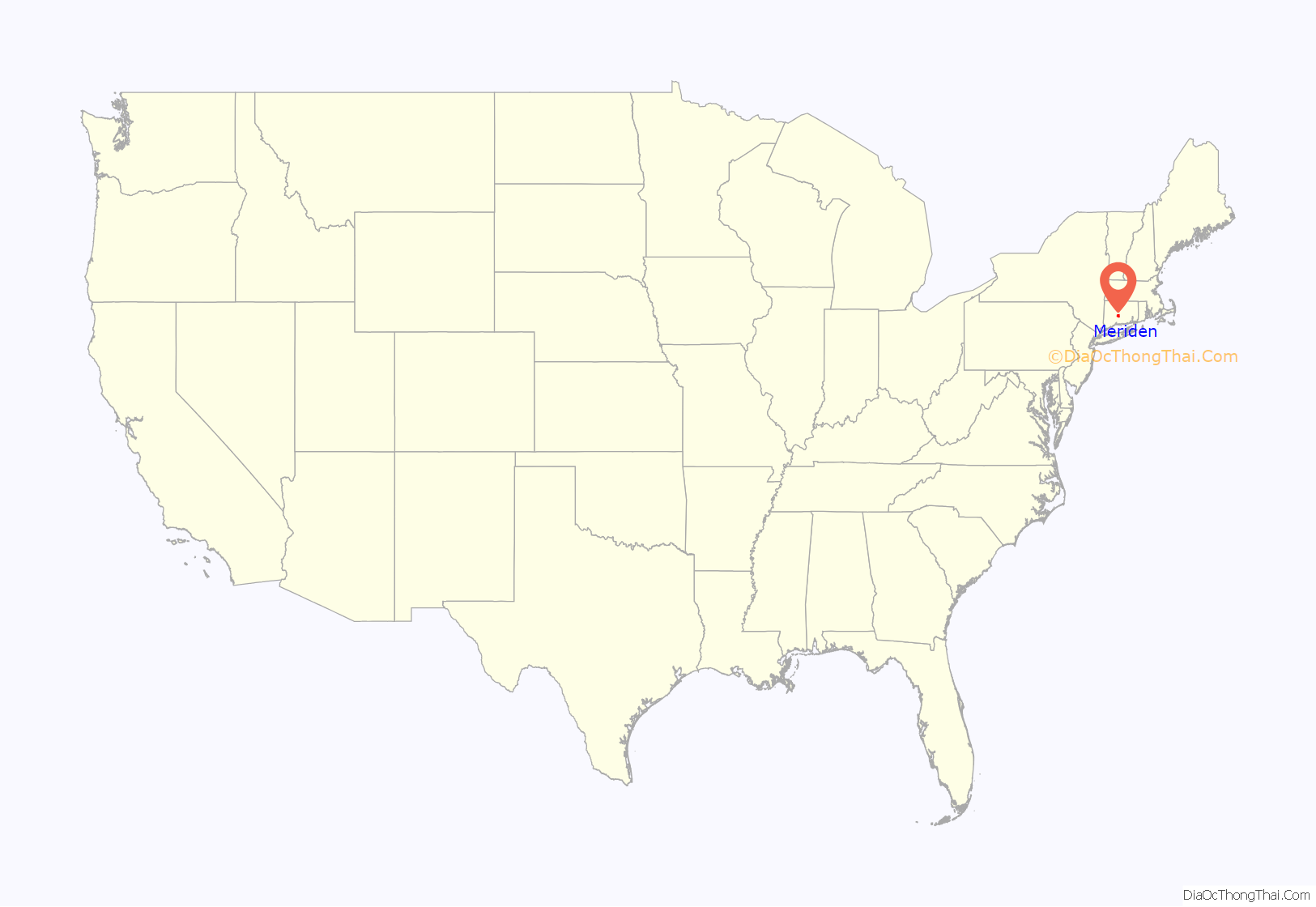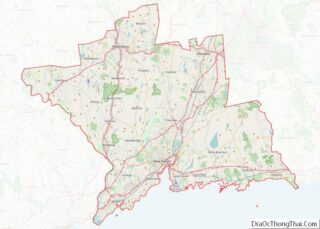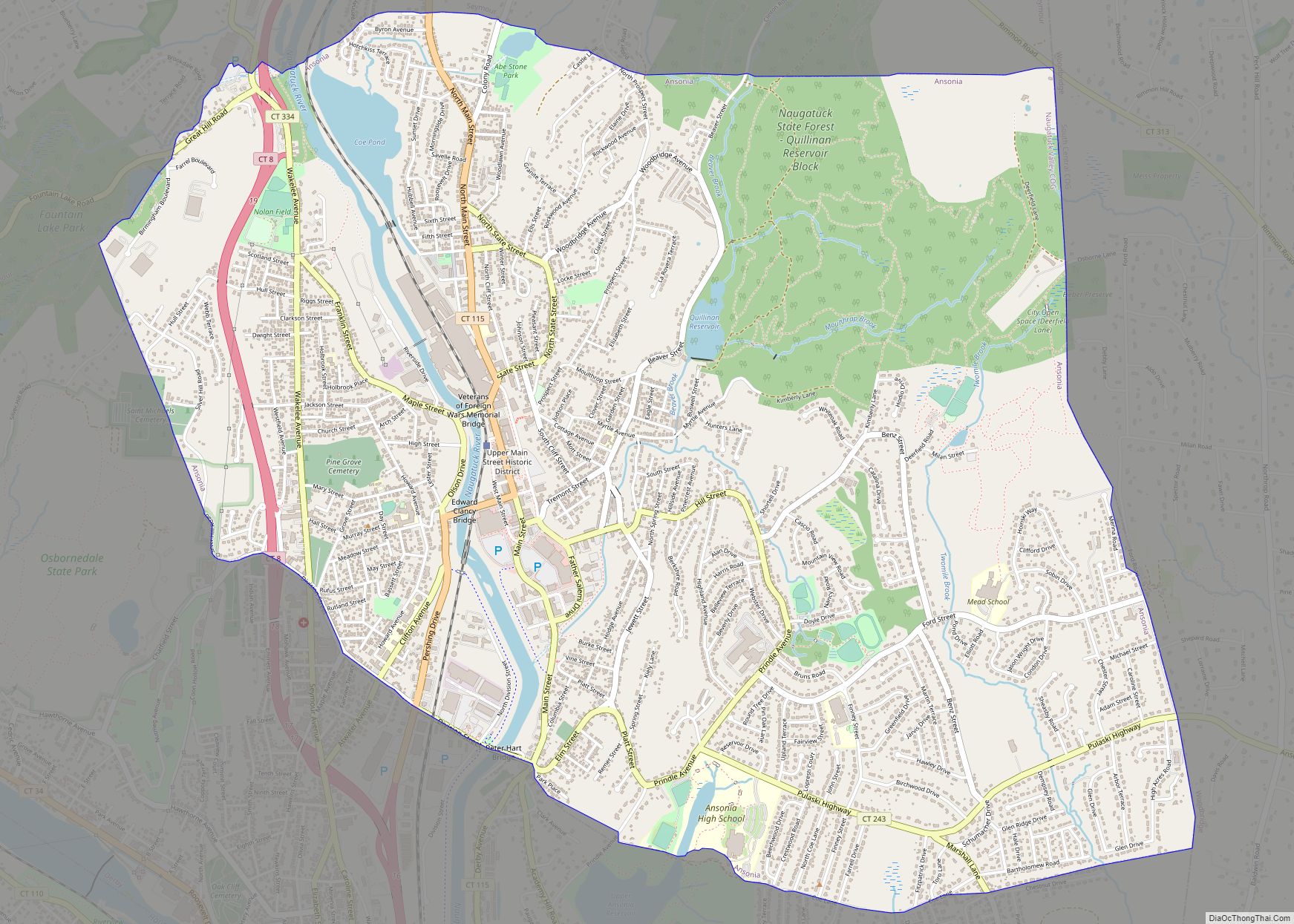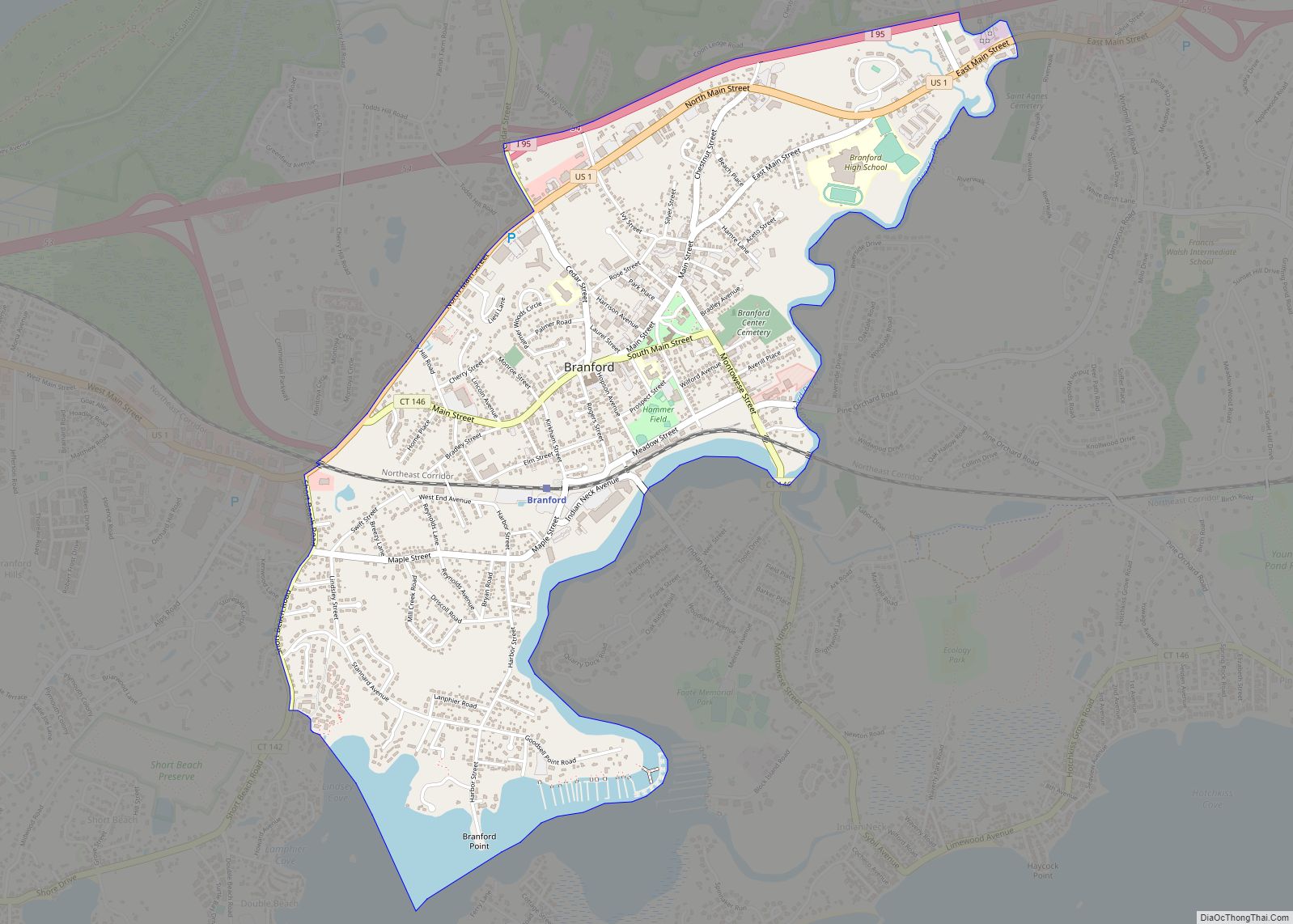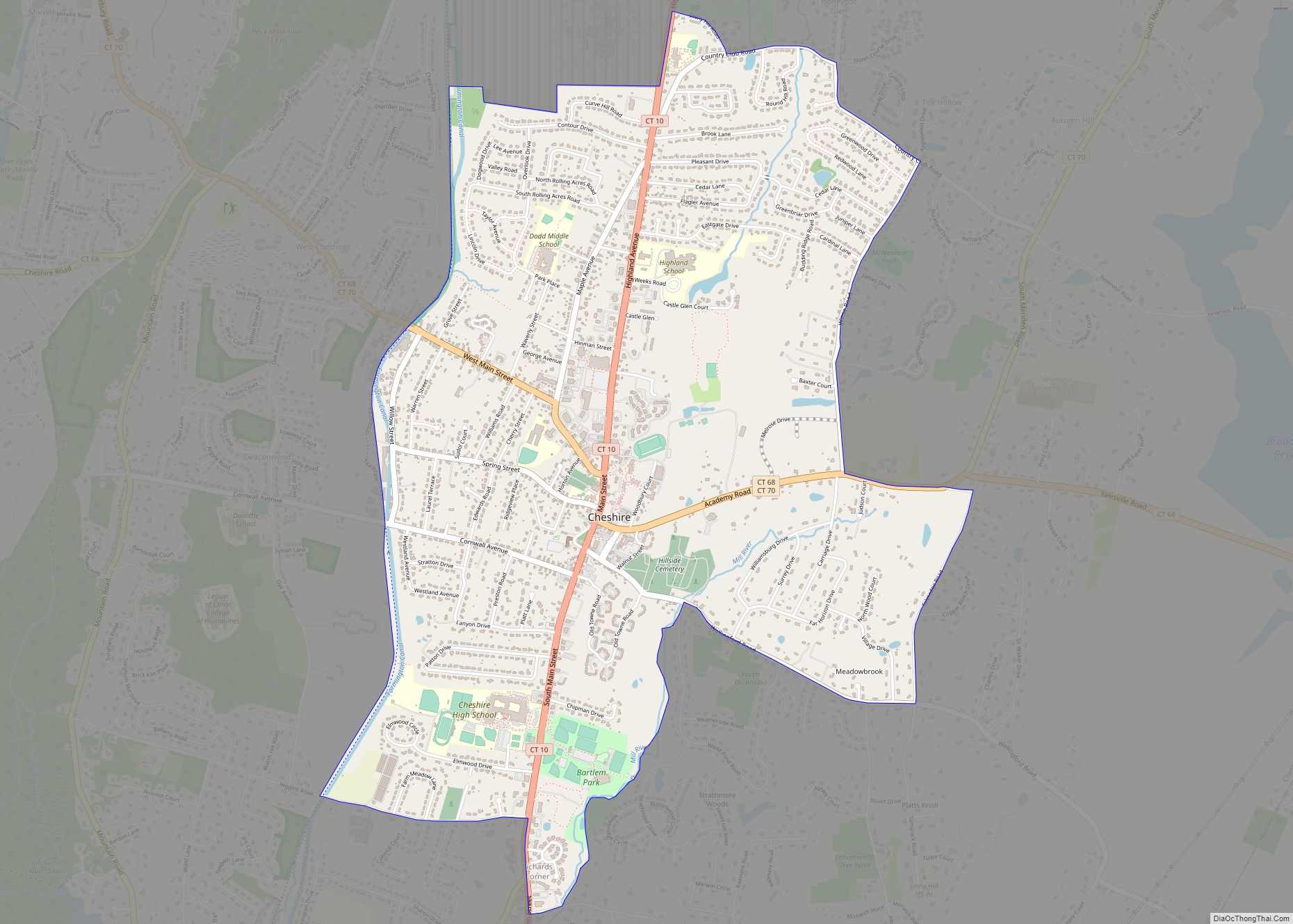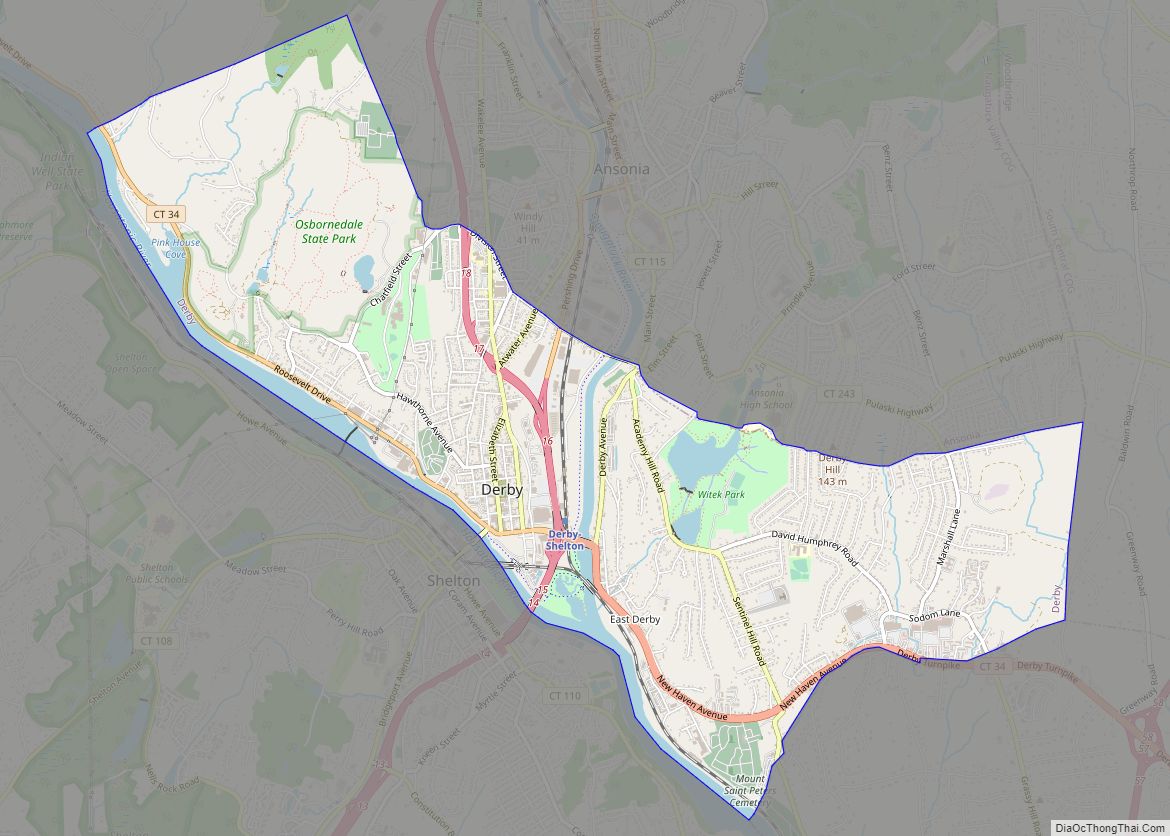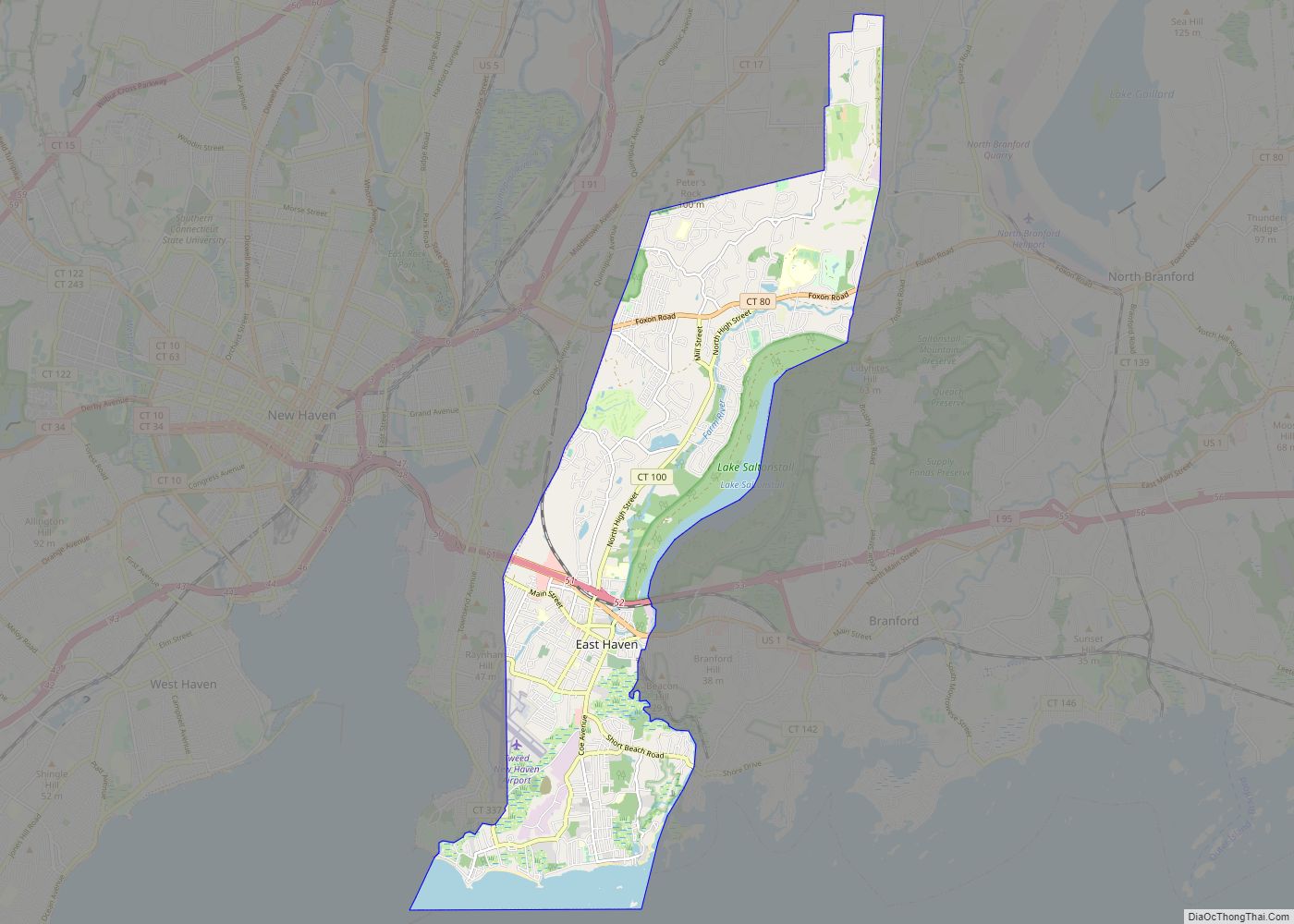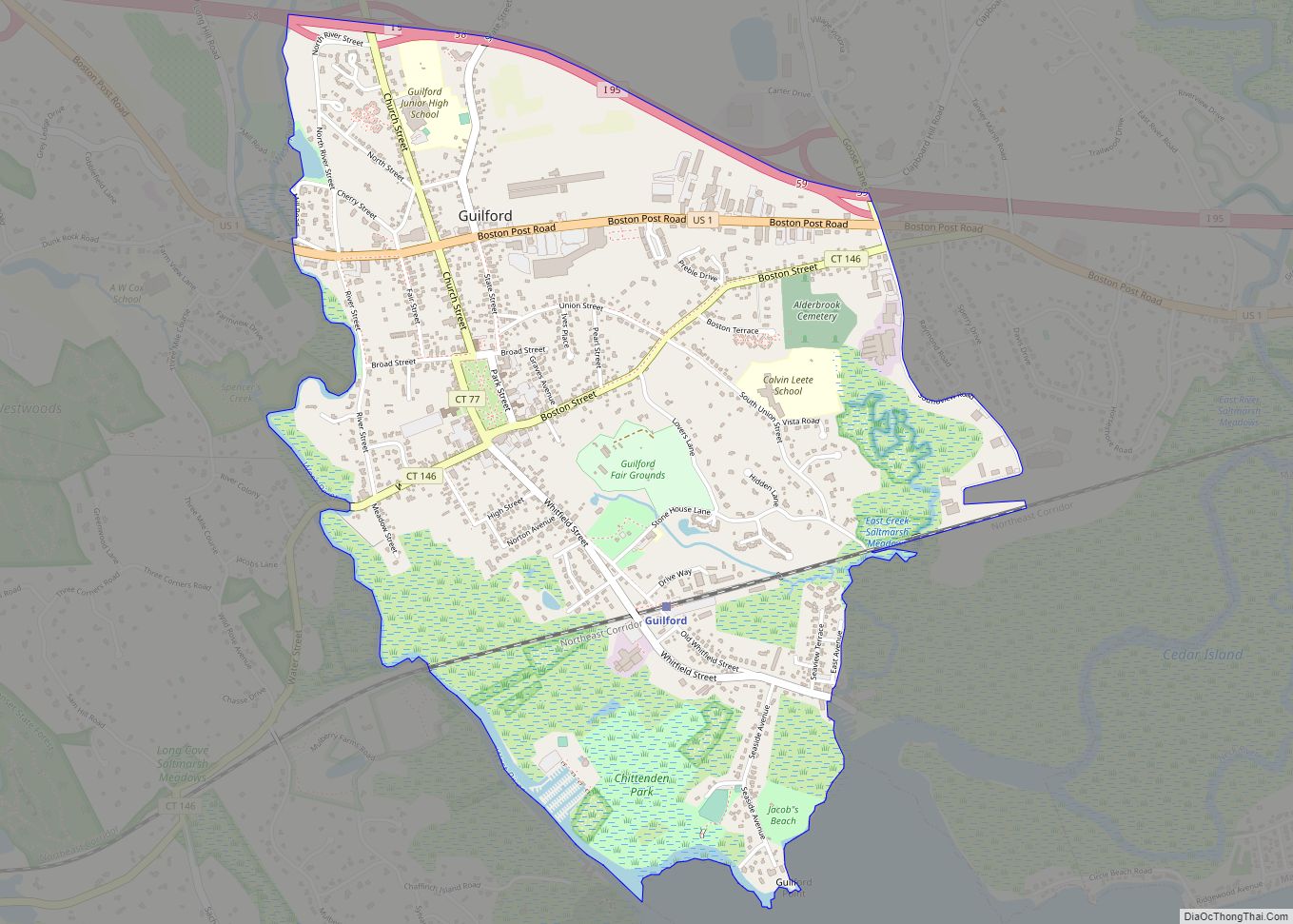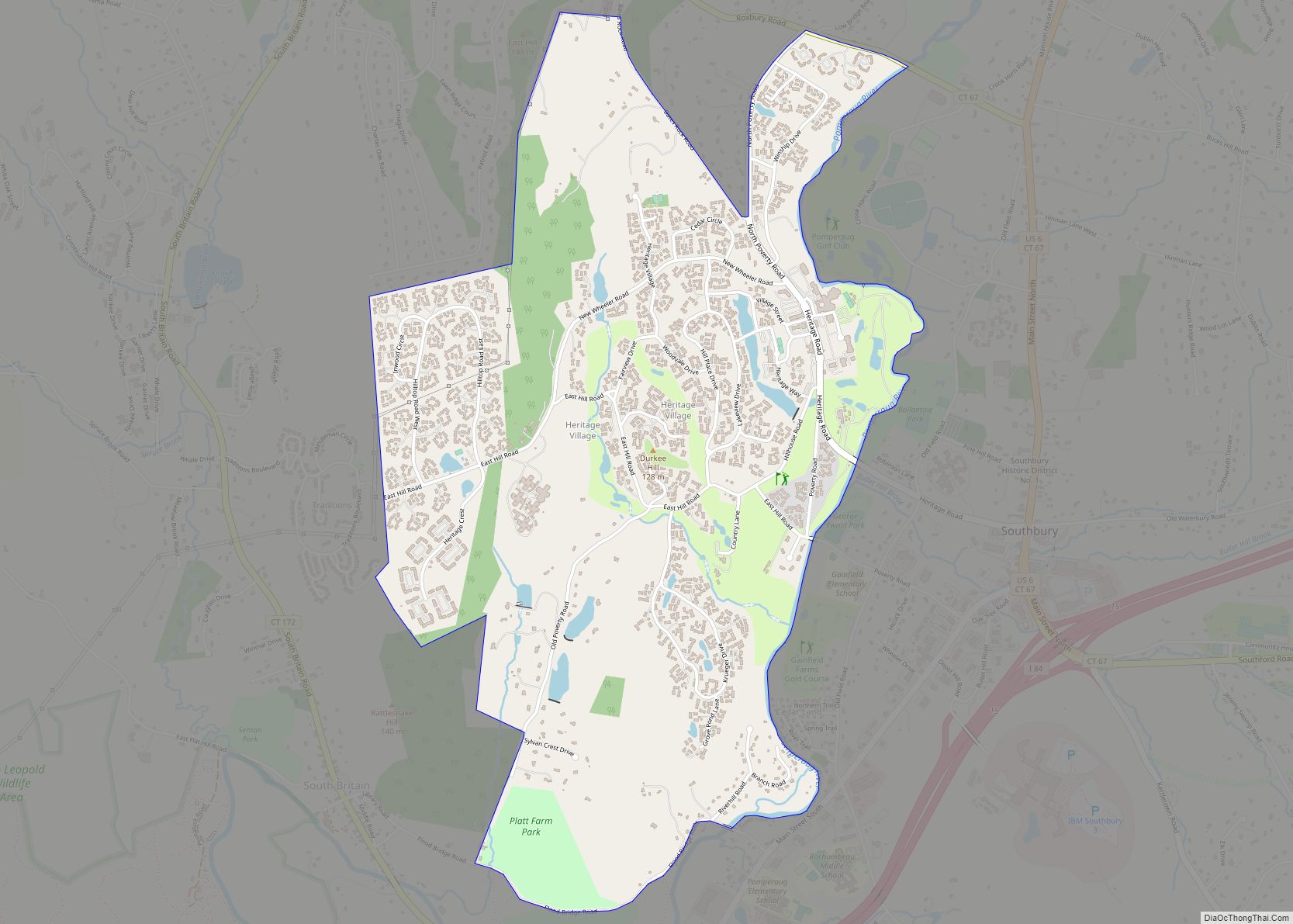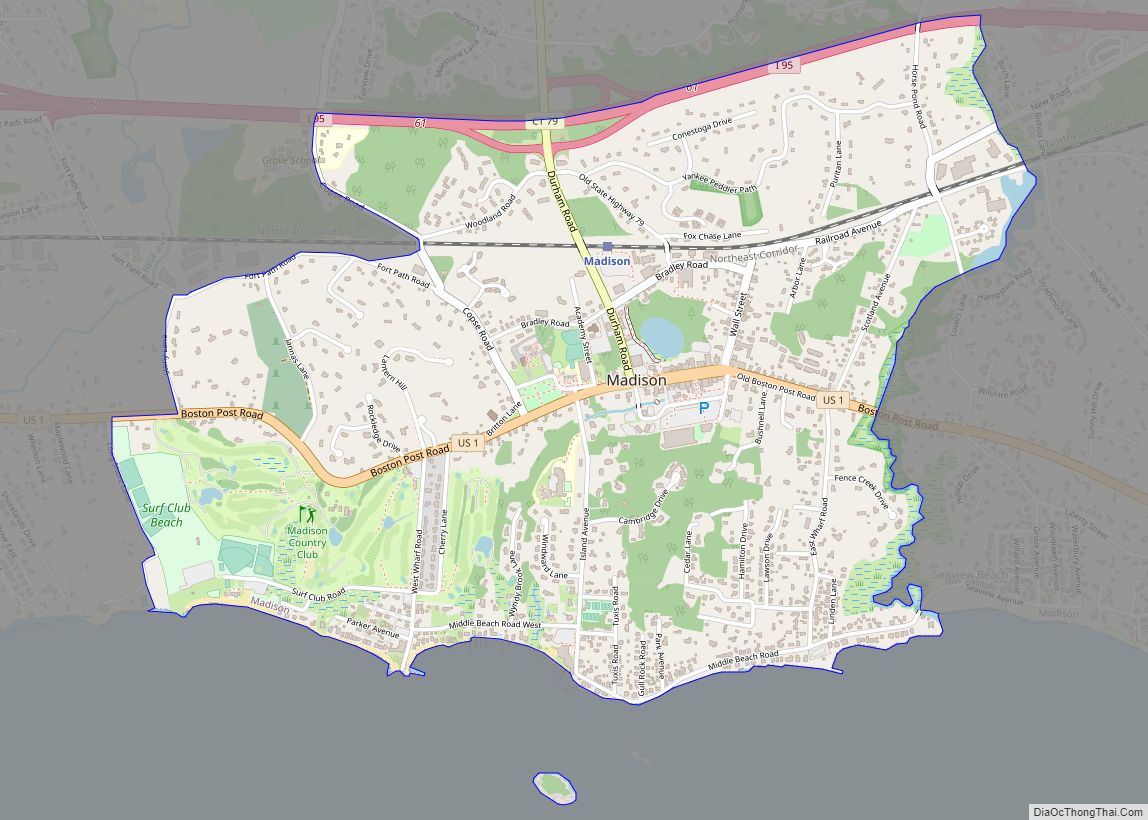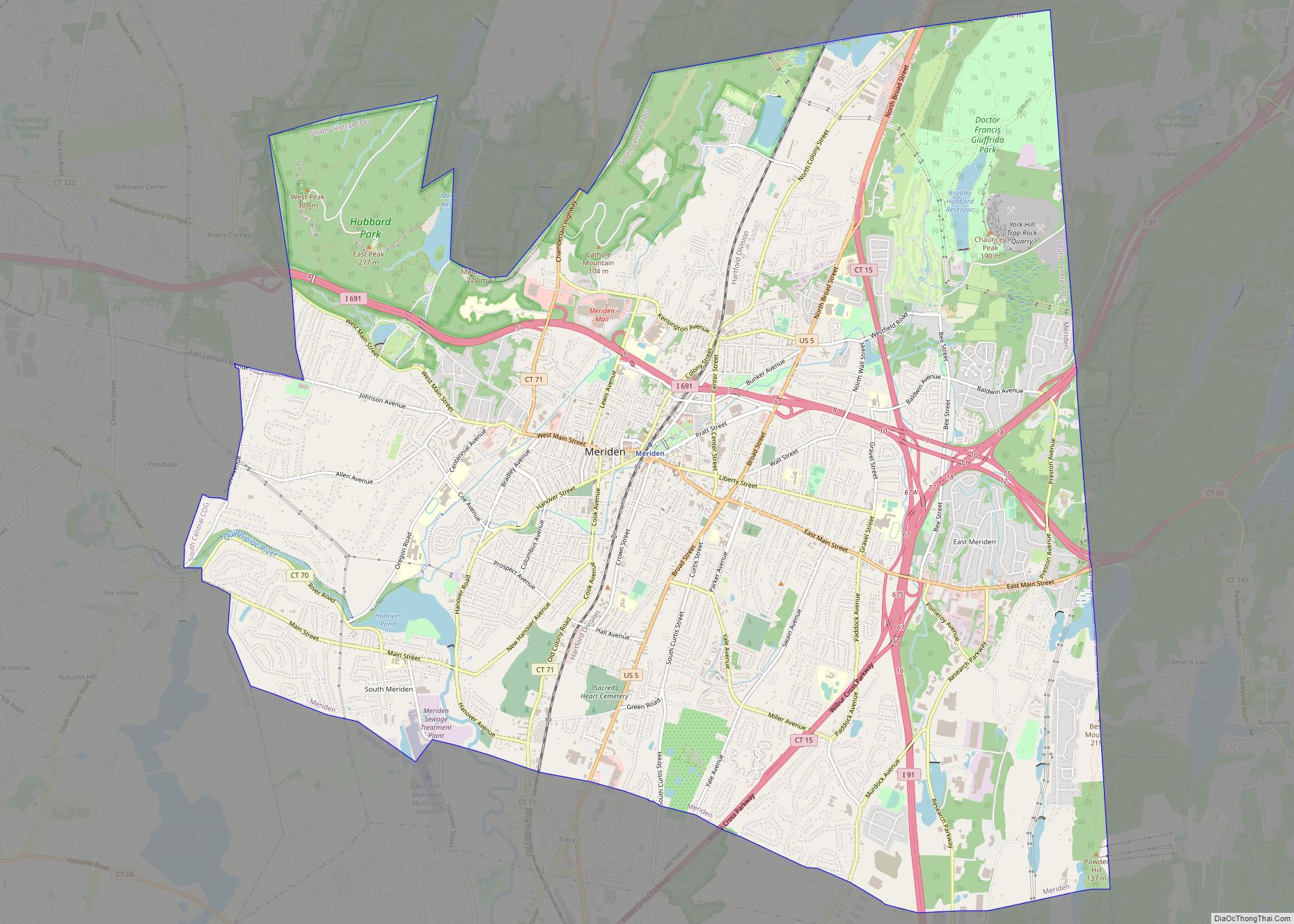Meriden is a city in New Haven County, Connecticut, United States, located halfway between the regional cities of New Haven and Hartford. The city is part of the South Central Connecticut Planning Region. In 2020, the population of the city was 60,850.
| Name: | Meriden city |
|---|---|
| LSAD Code: | 25 |
| LSAD Description: | city (suffix) |
| State: | Connecticut |
| County: | New Haven County |
| Elevation: | 177 ft (54 m) |
| Total Area: | 24.16 sq mi (62.58 km²) |
| Land Area: | 23.80 sq mi (61.64 km²) |
| Water Area: | 0.36 sq mi (0.94 km²) |
| Total Population: | 60,850 |
| Population Density: | 2,557/sq mi (987.2/km²) |
| Area code: | 203/475 |
| FIPS code: | 0946450 |
| GNISfeature ID: | 0208834 |
| Website: | www.meridenct.gov |
Online Interactive Map
Click on ![]() to view map in "full screen" mode.
to view map in "full screen" mode.
Meriden location map. Where is Meriden city?
History
18th century
Meriden was originally a part of the neighboring town of Wallingford. It was granted a separate meetinghouse in 1727, became a town in 1806 with over 1,000 residents. Meriden was incorporated as a city in 1867, with just under 9,000 residents. It was once proposed as the Connecticut state capital. It was named for the village of Meriden, West Midlands, England, near Birmingham.
The oldest house in town still standing, built by Solomon Goffe in 1711, became a museum in 1986. The building is the Solomon Goffe House.
The grave of Winston Churchill’s great-great-great maternal grandfather, Timothy Jerome, can be seen today at what is now called “Burying Ground 1720” (Google Maps: 41°31′22″N 72°47′16″W / 41.522877°N 72.787707°W / 41.522877; -72.787707) at the juncture of Dexter Avenue and Lydale Place. At the time the location was known as “Buckwheat Hill”, and overlooked the salt-making estate for which Jerome had received a royal grant. Timothy Jerome’s son, Samuel, is the great-great-grandfather of Jennie Jerome, Winston Churchill’s mother.
19th century to World War II
In the second half of the 1800s, Meriden became a manufacturing center of note, with several companies forming, or relocating to the city, involved in the production of mainly silver, lamps and metalware, glassware, guns, and musical instruments. A substantial number of design and technology patents were secured.
For silver, the numerous companies included the Meriden Britannia Company (a predecessor of the International Silver Company with corporate HQ in Meriden), Meriden earned the nickname “Silver City”, due to the large number of silver manufacturers, and the International Silver Co. continued production until the early 1980s. Along with the silver companies, other producers of cutlery included the Meriden Cutlery Co. and Miller Bros. Cutlery.
In 1876, the Meriden Britannia Company made significant efforts at the Centennial Exposition in Philadelphia, and won the First Place medal for plated wares. According to the Sotheby’s auction house, “The publicity of the award and the impression the firm made on the fair’s 8 million visitors was continued by the catalogues and other intensive marketing; by the end of the 1870s Meriden Britannia Co. was considered the largest silverware company in the world.” A key design attributed to launching the company and the town’s international name was the Buffalo Hunt with a smaller edition in the White House collection, Washington, DC. For some time the original Buffalo Hunt sculpture went missing, and in a shocking report by Bailey Wright in 2018, it was learned that it was recently ‘missing’ actually in Meriden.
For lamps and metalware, the companies with national and international markets included the Edward Miller & Co / Miller Company (1844–stopped manufacturing lighting c. 1980), the Charles Parker Company, Handel Company, and the Bradley & Hubbard Manufacturing Company (1852–1940), which also was widely known for producing metal-based products like decorative tables and andirons.
For glassware, the companies included the C.F. Monroe Company (1892–1916). and the Meriden Flint Glass Company (1876–1892),
Manning, Bowman & Co. (1849–1945) centered its production in Meriden, and into the early 20th century became a nationally known producer of small electrical appliances and chrome ware. Meriden was also the site of the production of Parker Brothers (guns), widely-known and traded by firearms enthusiasts. From 1905 to 1918, the Meriden Firearms Co. manufactured small arms from 1905 to 1918. The stock was owned by Sears, Roebuck & Company.
Internationally known companies Wilcox and White and the Aeolian Company were involved in the production of musical instruments north of the downtown area at Tremont and Cambridge Streets. The Aeolian Company grew quickly forming production sites in other places and developed a music hall in New York. (The largest holder today of instruments and music rolls by the two companies is the Pianola Museum in Amsterdam, The Netherlands.)
Meriden also was an important site for graphic arts innovation. In 1888, the Meriden Gravure Company (in Meriden 1888–1989) was founded by Charles Parker and James F. Allen, and continued a previous printing operation by Parker. The company developed an expertise in high quality image reproduction, which initially was driven by the needs of the silver industry.
With the wealth of entrepreneurs during this time, several mansions and houses of note were built, particularly on Broad Street.
Of political and historical note, on March 7, 1860, Abraham Lincoln spoke in Meriden seeking the Republican presidential nomination.
For public places, Hubbard Park in the Hanging Hills was financed by Walter Hubbard (of the Bradley & Hubbard company). The design for the park was originally conceived by Hubbard in consultation with the Olmsted Brothers, sons of Frederick Law Olmsted, America’s foremost landscape architect. In 1900, Castle Craig on a peak was dedicated in the park. In 1903, the Curtis Memorial Library, across from Meriden’s city hall, was opened.
From 1937 until 1947, the International Silver Company sponsored the Silver Theater, a national radio program broadcast via CBS in Hollywood. The radio program featured many Hollywood actors and actresses of the time like Jimmy Stewart and Rosalind Russell. Over 200 programs were produced. In c. 1937–1945, several Hollywood stars, including Judy Garland, Ginger Rogers and Barbara Stanwyck, endorsed the company’s 1847 Rogers Bros. silverware in print advertisements in LIFE magazine.
After World War II, in 1949–1950, The Silver Theatre was brought to television and broadcast on CBS, also with the International Silver Company as the sponsor. Guest stars included Eva Gabor, Kim Hunter, and Burgess Meredith.
A few thousand designs from this manufacturing era from Meriden are in museums and historical societies across the United States and into Europe, Australia and New Zealand. Design objects from this era from Meriden have also been included in over 200 national and international exhibitions and expositions since the 1850s. The 1930s tea urn by Eliel Saarinen for the Wilcox Silver Plate Co. / International Silver Company, Meriden, is the one design exhibited most and most published in design books as an international Modern design icon.
Some comparatively recent examples of Meriden designs in exhibitions include In pursuit of Beauty: Americans and the Aesthetic Movement at the Metropolitan Museum of Art in New York (1986–1987), and more recently, Modernism in American Silver: 20th century design (2005–2006) in Dallas, Miami Beach, and Washington, DC, which highlighted downtown Meriden and the area’s role as an important center of Modernist silver production. In 19th century Modern (2011–2012) in Brooklyn, designs by the International Silver Company and the Napier Company, another Meriden manufacturer, were exhibited. In November 2016-November 2017, the city’s iconic Napier penguin cocktail shaker was in an exhibition at the Dallas Museum of Art; the Napier penguin was the lead image of the show.
In summer 2017 alone, historical Meriden area design was exhibited in museum shows in at least Dallas, Newark, at the Museum of Modern Art in New York, the Cooper-Hewitt Smithsonian Museum in New York, the Gemeentemuseum in The Hague, The Netherlands, and the KunstHalle in Berlin, Germany.
With this level of attention, some special design objects from the era have become sought-after collectors items also at auction, sometimes due to their association with the commission or commissioner, or the status of the design, or being in the sought-after Modernism style. For example, a painted glass and metal table lamp by Bradley and Hubbard, (c. 1920) sold for US$14,950, doubling its estimate, at Christie’s auction house in New York in 1999. Later, a 14-inch, International Silver Company cocktail shaker (c. 1927) sold for US$21,600 tripling its estimate, at Christie’s in New York in 2005. A Parker gun made for a Russian czar before World War I, but never delivered, was reported to have been sold for US$287,500 in 2007. In 2008, a rare Handel lamp sold for US$85,000. On March 5–6, 2014 at Sotheby’s in London, “Al Capone’s cocktail shaker” made by the Meriden International Sterling Company (c. 1932) achieved over 33 times its estimate with a sale price of GBP50,000 (US$83,250 on the day). Lastly, in 2014, at Sotheby’s New York, a rare Paul Lobel-designed coffee service (c. 1934–1935) produced by the Wilcox Silver Plate Co. / International Silver Company sold for US$377,000.
WWII–1970s
In 1939, Edwin Howard Armstrong, a network radio pioneer who invented FM radio, used West Peak in 1939 for the location of one of the first FM radio broadcasts. His original 70-foot-tall (21 m) radio mast still stands on the peak. Currently West Peak is home to six FM broadcast stations, including WNPR, WWYZ, WKSS, WDRC-FM, WMRQ-FM and WHCN.
During World War II, factories in Meriden worked three shifts (24 hours/day). On March 8, 1944, the War Manpower Commission gave Meriden the designation as “National Ideal War Community”, and Jimmy Durante and Glenn Miller entertained those at the ceremony.
In addition to manufacturers that continued operations after World War II, starting in the later 1940s, the Miller Company, Burton Tremaine, Sr. and Emily Hall Tremaine firmly put Meriden on the international, 20th century art/design map. In December 1947, Meriden became known once again as a site of design innovation, now with Modern art, via the Miller Company Collection of Abstract Art and the organization of a Painting toward architecture exhibition which opened at Hartford’s Wadsworth Atheneum and later travelled to venues in 27 venues across the United States (1947–52). Substantial national media coverage reported on the exhibition. Painting toward architecture is considered one of the important art-design-architecture crossover exhibitions of the 20th century, tabling European influences for usage in the Post-World War II United States. In the 1950s, the Miller Company Collection of Abstract Art was privatized to “Mr & Mrs Burton Tremaine, Meriden, CT” and numerous artworks were lent to hundreds of exhibitions nationally and internationally into the 1970s with this designation.
In 1965, the Miller Company addition on Center Street was completed. The black-and-white Modernist facade was designed by influential American architect Philip Johnson.
On April 27, 1976, Jimmy Carter campaigned at city hall and the Latin American Society for the nomination of the Democratic Party for President of the United States.
1980s–present
In 1981, the Ku Klux Klan was present in Meriden, holding various rallies in the first half of the year. At these rallies, Connecticut State Police would protect the KKK from anti-KKK protestors. At a March 21, 1981 rally, where the KKK was showing support for a police officer who killed a Black person, protestors threw rocks at the KKK. Two protesters were injured.
In 1987, the Emily Hall Tremaine Foundation was founded by the noted art collector that partly worked in Meriden, before her passing, with three focus areas: learning disabilities, the arts, and the environment. The offices were located in downtown Meriden. In c. 2010, the foundation offices were relocated to New Haven, near Yale University.
Meriden was a location chosen for the filming of the 1989 film Jacknife directed by David Jones starring Robert De Niro, Ed Harris and Kathy Baker. De Niro played a Vietnam War veteran suffering from post-traumatic stress disorder adjusting to a return to American life. The film was adapted by the play, Strange Snow by Stephen Metcalfe, a native from the adjacent town of Cheshire, Connecticut. A number of Meriden locations can be seen in the film, including a historic house on Linsley Avenue, as well as film locations in the greater region.
The Franciscan Sisters of the Eucharist have their mother house in Meriden, as do the Franciscan Brothers of the Eucharist.
Meriden Road Map
Meriden city Satellite Map
Geography
According to the United States Census Bureau, the city has a total area of 24.1 square miles (62.5 km), of which 23.8 square miles (61.5 km) is land and 0.4 square miles (1.0 km), or 1.66%, is water.
Meriden is a showcase for a number of prominent peaks of the Metacomet Ridge, a mountainous trap rock ridgeline that stretches from Long Island Sound to nearly the Vermont border. Notable peaks in Meriden include the Hanging Hills (West Peak, East Peak, South Mountain, and Cathole Mountain); Lamentation Mountain, Chauncey Peak, and Besek Mountain. Castle Craig, a city landmark for over a century, was constructed among the Hanging Hills in Hubbard Park.
The Quinnipiac River courses through the southwest quadrant of the city, known to area residents as “South Meriden”, where it meanders through a gorge lined with several exposed sandstone and brownstone cliffs. Harbor Brook (originally named Pilgrim Harbor Brook) cuts through the town from the northeast to the southwest before emptying into Hanover Pond, an impoundment on the Quinnipiac River in South Meriden.
Principal communities
- Meriden Center
- South Meriden
See also
Map of Connecticut State and its subdivision: Map of other states:- Alabama
- Alaska
- Arizona
- Arkansas
- California
- Colorado
- Connecticut
- Delaware
- District of Columbia
- Florida
- Georgia
- Hawaii
- Idaho
- Illinois
- Indiana
- Iowa
- Kansas
- Kentucky
- Louisiana
- Maine
- Maryland
- Massachusetts
- Michigan
- Minnesota
- Mississippi
- Missouri
- Montana
- Nebraska
- Nevada
- New Hampshire
- New Jersey
- New Mexico
- New York
- North Carolina
- North Dakota
- Ohio
- Oklahoma
- Oregon
- Pennsylvania
- Rhode Island
- South Carolina
- South Dakota
- Tennessee
- Texas
- Utah
- Vermont
- Virginia
- Washington
- West Virginia
- Wisconsin
- Wyoming
